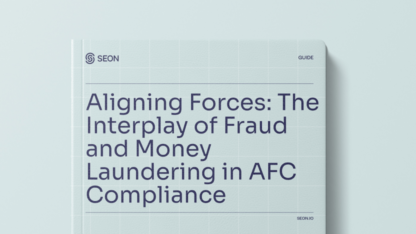While Ultimate Beneficial Ownership may sound like a good thing, it is a term designed to help bring transparency to business practices that otherwise might be exposed to criminal money laundering and terrorist financing.
Establishing the ultimate beneficial owner (UBO) of a company is essential for a compliant AML program because criminals tend to hide their financial holdings behind layers of obfuscation. The financial mechanisms that exist to aid this obfuscation can make identifying UBOs a massive challenge, and the penalties for not making every effort to do so can be equally daunting.
Minimizing risk and non-compliance exposure begins with education.
Let’s get to know some of the intricacies of the practice so establishing ultimate beneficial owners feels less like clawing around blindly in a dark room.
What Is Ultimate Beneficial Ownership?
Ultimate beneficial owners are those individuals who control or take gains from their stakeholding in a company. After the relationship between criminal financing and beneficial ownership was flagged in the late 1980s, the Financial Action Task Force (FATF) introduced its first legislation to combat the ability to hide beneficial ownership in the US. Other countries followed suit with anti-money laundering legislation.
Even in complex, carefully-structured ownership arrangements, UBO individuals must be identified in order for the organization to comply with anti-money laundering laws.
These laws make sure businesses are not dealing with sanctioned entities, or entities who are otherwise likely to be using money with malicious intent. With every new set of fincrime regulations, the definition of the UBO expands to better set a perimeter around new technologies in obfuscation.
Partner with SEON to boost your AML compliance without friction and stop all kinds of fraud with real-time data enrichment and advanced APIs.
Ask an Expert
Who Is the Beneficial Owner (UBO) of a Company?
Entities that are over specific thresholds of control through capital gains, investment or voting power are considered to be a company’s ultimate beneficial owner. Certain verticals need to be particularly mindful and diligent about monitoring these margins, particularly banking, finance, real estate, accounting, and some other high-value trades like art dealerships.
Currently, the thresholds of control of an organization that define a UBO include:
- holding at least 25% of the capital investment stake in a legal entity
- controlling at least 25% of the voting power of a legal entity
- receiving at least 25% of the generated capital from a legal entity
Notably, legislation and legal device for companies that want to make sure they are AML compliant mention that these thresholds can change, and that companies can potentially be held accountable for historical noncompliance violations.
This same language also suggests that a skeptical eye should be turned toward customers who come near these thresholds but don’t quite go over them.
How Do You Prove Beneficial Ownership?
When it comes to determining the UBO of a company with any degree of confidence, there is really only one surefire strategy: digital legwork and on-the-ground elbow grease. Usually, it is financial experts who will have to chime in to ensure every aspect of organizational structure is examined.
The mere existence of UBO regulations suggests that criminals and money launderers are accustomed to burying their money under as many layers of misleading information as possible. Currently, there is no all-encompassing digital or analog pathway to finding a UBO that does not twist and turn, short of simply outsourcing that duty.
To prove ownership, an ultimate beneficial owner’s name and date of birth must be unearthed. These data points will, in turn, have KYC checks run on them to ensure the individual is not sanctioned or a PEP. Only then can the UBO be ascertained and business with that company can continue normally.
However, to find that name and date of birth – which may be hidden under pseudonyms, intermediaries, and shell companies (which may themselves also have a complex structured ownership) – a team of financial sleuths is necessary. That team will need to:
- Acquire and scrutinize company credentials (i.e. KYB Checks) to make sure they are accurate and up-to-date. These pieces of information will be the starting point for a UBO inquiry, so any anomalies or inaccuracies at this stage might be a red flag. Compliance teams should be checking the veracity of key points like registration data that includes names and addresses, any transparently associated financial information, as well as a comprehensive list of senior management, who should all be screened as part of UBO due diligence.
- Identify key stakeholders of the ownership structure, a process that will almost certainly require close research. Digging into listed ownerships may lead to other companies which will, in turn, need to be researched, and this chain may have any number of links. The intricacies of direct and indirect ownership in deference to the 50 percent rule may need to be observed. Plus, to comply with the 25% threshold of control, a dive into the upper management structure to determine voting rights is part of best practice. But this itself may be complicated.
- Isolate ultimate beneficiaries by quantitatively determining those who fall within the 25% perimeter. These names must then have KYC and AML due diligence carried out on them, so that their appearance on sanctions lists and other watchlists may be checked.
Why Is Establishing the Ultimate Beneficial Owner Important for AML?
Absolutely determining the UBOs for a given company is crucial to combating money laundering and the funding of terrorism – and staying compliant with relevant legislation to avoid fines. UBO checks are a direct response to criminals using unnecessarily complex ownership structures to control a company, then use that apparently legit company to move money from illegal channels to legal ones.
The mechanisms used to hide a criminal’s involvement in a legal entity are always evolving, as are the regulations to catch them – very much like an arms race.
Failure to take up modern arms to fight money laundering can lead to penalties that are vital to avoid. For example, as a US entity or personage, dealing with a company known to be controlled by a sanctioned individual could result in large fines, reputational damage or, perhaps the worst, becoming a sanctioned entity yourself.
The Levels of UBO Risk
Different ultimate beneficial owners and different companies present different levels of risk exposure for those who would seek business dealings with them. Though there is no concrete metric for determining which entity falls into which risk level, knowing your company’s risk appetite and combining it with some general common sense should suffice as a starting point.
After sifting each company into a low, medium, or high-risk category, proceed accordingly.
1. Low-Risk UBOs
Generally, companies that fall into this category – be it through being too small to be threatening, or the general unlikelihood of an Etsy storefront owner to be money laundering through knitwear – will require little due diligence action.
A simple collection of verifiable personal data, perhaps a hard identity verification check on state documents, will suffice in most cases.
2. Medium-Risk UBOs
Entities who might appear on a PEP (politically exposed persons) list but not on other sanction lists might be considered medium risk, though this scale slides depending on the company’s risk appetite. Other medium-risk entities might fall into this category based on their capital scale.
An example might be, say, the child of a state leader. Since their name might appear on the PEP list, they represent a risk because it’s possible they could be used as a mechanism for corruption. That being said, any number of companies would also be happy to have that person’s business.
These cases should entail a KYC process that is much the same as for high-risk UBOs:
- Conduct enhanced, general searches to determine if the person in question has any recent risk exposure such as legal woes or media coverage.
- Detailed scrutinization of wealth disparities – particularly for medium-risk UBOs who may not be sanctioned in any way, but whose corruption risk is higher. Check apparent sources of income and overall wealth status versus any transactions they are making to make sure there are no anomalies that suggest financial crime.
- Collect quantitative evidence that the nature of the person’s actions is understood to be non-criminal.
- Make sure these activities are consistent, and request updates should the situation change, making sure to document any changes.
3. High-Risk UBOs
Like the above medium-risk persons, high-risk entities should be subjected to your enhanced due diligence processes. High-risk individuals who show a tangential relationship to named persons on sanction lists or who are otherwise narratively sanctioned (family of sanctioned persons or unnamed members of named terrorist groups, for example) should be approached with caution.
If such persons approach your business, carry out the above due diligence practice with care. Keep in mind that most international AML statutes suggest that bookkeeping is important, as is self-reporting should your company fall into noncompliance.
As regulations evolve, customers who were previously considered low-risk may be redefined as high-risk, and in these cases, the best thing for your bottom line will be to be able to present your data accurately and receive leniency in return.
Partner with SEON to reduce fraud rates in your business with real-time data enrichment, whitebox machine learning, and advanced APIs.
Ask an Expert
How Can SEON Help Identify UBOs?
Currently, there isn’t a single reliable way to fully automate the identification of ultimate beneficial owners of companies. Financial risk management tools such as SEON are only one facet of an effective compliance program, the majority of which will be carried out through meticulous manual research. However, such software can help investigations.
After a compliance team has got its hands dirty by bringing together a list of individuals whom it would be best practice to scrutinize, SEON is an easy solution for screening those individuals for risk exposure.
A simple manual query will show any matches – hits – from any major watchlists, including sanctions, PEP, crimes, and more. You can try this functionality for free here:
A name appearing as a hit on any of these lists should trigger whatever protocol your company has in place, such as filling in a SAR or some other practice to take responsibility for the situation. SEON also keeps automated data transcripts, which are a crucial part of proving compliance should an inquest occur.
Particularly in the case of low-risk UBOs, SEON can also help cut down on hard KYC checks by providing a confident risk assessment without the expense of the actual check. In the face of the monumental task of consistently identifying UBOs, businesses would be wise to secure their bottom lines by minimizing these costs at every opportunity.
FAQ
UBOs are always a nameable person, on whom enhanced due diligence (EDD) ought to be carried out. If the beneficial owner of a company appears to be another non-person entity, more research must be carried out to identify the UBO of that entity.
Only entities that have no individual beneficial owner do not have to be scrutinized for a UBO. These are almost always government-owned bodies.








